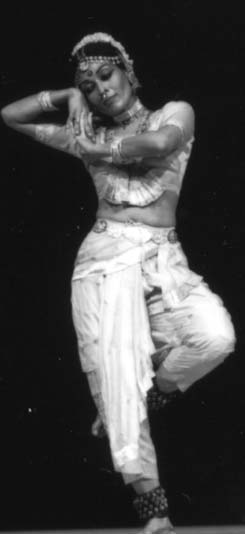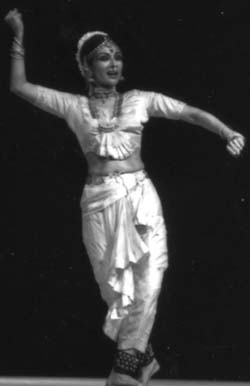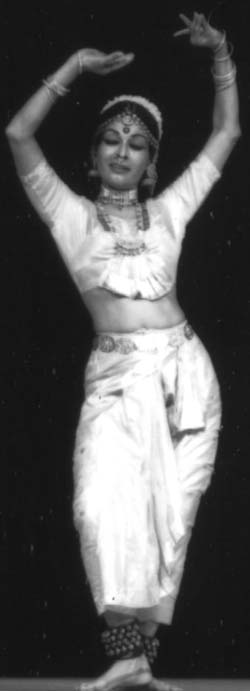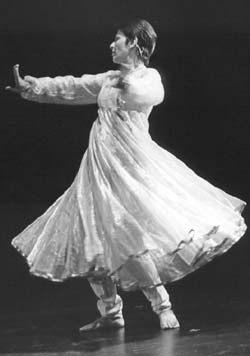|
Devi:
The Mother Goddess
About
Thank
you
Cast
Interview
Reviews
|
April 9,1999, INDIA ABROAD, Page 45
Sarabhai presents
dances on Devi theme in N.Y.C.
By JYOTIRMOY DATTA
NEW YORK - Although the
Mother Goddess has always had a central role in Hindu mythology
and belief, noted dancer and activist Mallika Sarabhai cast a sharply
contemporary light on the role of woman in her presentation of "Devi:
The Mother Goddess" at the Museum of the American Indian in New
York on March 29 and 30. "Devi: The Mother Goddess" is a sequence
of six short dances Sarabhai specially choreographed for the opening
of a groundbreaking exhibition of the same title at the Smithsonian
Institution's Arthur M. Sackler Gallery in Washington, D.C., on
March 28.The New York performances were presented by the Smithsonian
National Museum of the American Indian, the Indo-American Arts Council
and the Battery Dance Company in cooperation with the Smithsonian
Freer Gallery of Art and Arthur M. Sackler Gallery, and were sponsored
by the founding sponsor of the Arts Council. India Abroad, the State
Bank of India and the Lexington Hotel. At the opening, Sarabhai
depicted the creation of the universe by Devi. This was followed
by a dance to the seven manifestations of Devi. the seven goddesses
traditionally worshiped by Hindus. Next came innovative interpretations
of Draupadi, the central feminine figure of the epic, Mahabharata,
and of Savitri, held up by generations of men as the model Hindu
wife.
Sarabhai introduced a comic element in the next dance - about not
a goddess but a woman who just missed deification. Her rendering
of a one-eyed monkey and of a Brahmin made the audience burst into
laughter. The evening concluded with a vigorous and passionate celebration
of the lion-mounted slayer of demons, the mighty Katyayani, at the
end of which Sarabhai danced on canvas, printing the image of a
lion with the tapping of her feet. She interspersed the dancing
with arguments, poetry and song. It was a triumphant celebration
of woman as energy, power and beauty. |
 |
 |
At an interview at India Abroad
on March 30, Sarabhai was asked to comment on painting with one's
feet:
Sarabhai: It is part of the Kuchipudi tradition. It used
to be done at Srikakulam temple on the occasion of the chariot procession.
The last time my guru C.R. Acharyalu saw it performed was when he
was 5 years of age. And he taught it to me about 70 years later.
He taught me to draw four figures; for Ganesha, I draw Ganesha,
for Kartikeya I draw a peacock, a lotus for Lakshmi and for Katyayani
a lion.
Q. What is the concept of the Devi exhibition?What was the
idea of its curator, Vidya Dehejia?
Sarabhai: She (Dehejia) has taken the manifestation of the
Devi, the female principle, through 2,000 years of Indian art history,
she has taken forms of Devi from the classical tradition, the tantric
and the folk, and its contemporary forms. All of it is there. It
is a fresh look at woman on the eve of a new millennium. When she
commissioned me to do the dances, she told me 'Mallika, do a Mallika
piece. I have been working with manifestations of women, with historical
women, with goddesses, for many years. Indeed this is my own issue,
my core theme. The Draupadi piece that 1 did yesterday was written
by my brother Kartikeya in Gujarati after seeing me doing Draupadi
in Mahabharata. I had it translated into Tamil for the vocal accompaniment |
|
Q. Will you do the pieces in India
that you did here? Will not this attack the traditional view that
uwnen cause commotion?
Sarabhai: I have to do what I have to do. Anyway, this
is much less radical than most of my other work. I have done over
300 shows of my "Site's Daughters" all over the world. Even today,
most daughters are told "Sitajaisi ban na," meaning "be passive,
be a doormat be stamped upon." The Sita piece is much more hot
politically.
Q.Why?
Sarabhai: Because of the Ram Janmabhumi and the BJP and
the VHP. "Sita's Daughter" is about today.
Q. And it all comes through in your performance. It was
so powerful that naturally it endangers the status quo.
Sarabhai: As a world citizen woman at the end of the century.
I feel that as an artist I do not have the luxury of saying 'Shiva
I love you very much, won't you come, I am longing for you.' Look
at the mess the world is in at the end of the century! We have
more hatred, more violence, more of everything negative than ever
before. I am a political being. And I have in my hand an amazing
instrument of communication. And I will use it for the things
that bother me. For example, human rights, women's rights, racial
rights.
Q. We have heard about your mixed background;
can you elaborate?
Sarabhai: I am a mongrel. I am quarter Tamil, quarter Malayali,
quarter Gujarati, quarter Kachchi. My Tamil musicians, however,
have lived in Ahmedabad most of their lives.
Q. Tell us about your bus trip with Vajpayee toLahore.
Sarabhai: It was very decent of Vajpayee to choose two
women who were very strong advocates of women's rights, me and
Veena Nayyar of Women's Political Action Group. There was a lot
of controversy over whether he should take only politicians or
only film stars, but I think Vajpayee took a concerted decision
that he would take with him two women who could show Pakistan
the status of women in India. Yes, there were lots of women who
were having a rough time, but yes, there were also lots of women
who were fighting. Both of us are very antiestablishment Vajapyee
clearly wished Pakistan to know India was not just Bollywood.
His call came at 11 o'clock at night 48 hours before the trip.
I was due to go to Nepal. I dropped everything and took the bus
to Lahore.
|
 |
 |
Q. Considering your actinism
and your radical views, if was very interesting that Vajpayee took
you along.
Sarabhai: Yes, Vajpayee must be commended on the courage
to take us. I am very open in my opposition to BJP's mix of politics
and religion. I think politics and religion have nothing to do with
each other. I am opposed to any group, to any party, anywhere that
mixes religion with governance.
Q. What is your political affiliation, if at all today.
Sarabhai: At the moment with nobody, because out there, there
is only a bunch of nothings, everybody is crossing over and changing
colors and...
Q. Did you have a favorite politician?
Sarabhai: Lal Bahadur Shastri. I think if Shastri hadn't
died, I think India would have been a very different place. When
he asked the nation to fast once a week, you knew he himself was
doing it Where are the politicians today who practice what they
preach? |
|

